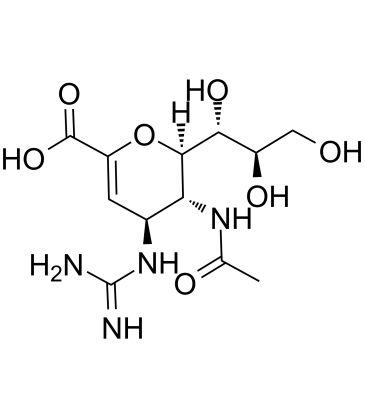| Cas No.: | 139110-80-8 |
| Chemical Name: | (2R,3R,4S)-3-acetamido-4-(diaminomethylideneamino)-2-[(1R,2R)-1,2,3-trihydroxypropyl]-3,4-dihydro-2H-pyran-6-carboxylic acid |
| Synonyms: | GR-121167X; GR121167X; GR 121167X; GG167; GG-167; GG 167; Zanamivir; trade name Relenza. |
| SMILES: | O=C(C1=C[C@H](/N=C(N)\N)[C@@H](NC(C)=O)[C@H]([C@H](O)[C@H](O)CO)O1)O |
| Formula: | C12H20N4O7 |
| M.Wt: | 332.313 |
| Sotrage: | 2 years -20°C Powder, 2 weeks 4°C in DMSO, 6 months -80°C in DMSO |
| Description: | Zanamivir is an influenza viral neuraminidase inhibitor with IC50 values of 0.95 nM and 2.7 nM for influenza A and B, respectively. |
| In Vivo: | Zanamivir has a poor bioavailability in oral administration, with only 4–17% of the agent. Oral delivery of zanamivir has been a problem due to its strong hydrophilic nature that limits its transport across the intestinal epithelium. Permeation enhancers such as sodium cholate, hydroxypropyl β-cyclodextrin could be used with zanamivir to enhance the intestinal permeability[3]. |
| In Vitro: | Zanamivir interacts with a group of amino acids in the active site of neuraminidase, which are conserved in all influenza A and B strains. Zanamivir blocks the action of neuraminidase, which prevents the cleavage of sialic acid on the cell receptors, thus preventing release and spread of the newly formed virions[2]. |






















